Related Research Articles
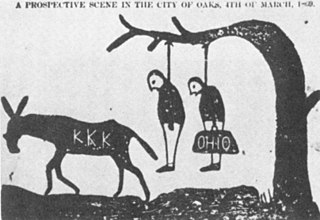
In United States history, the term scalawag referred to white Southerners who supported Reconstruction policies and efforts after the conclusion of the American Civil War.
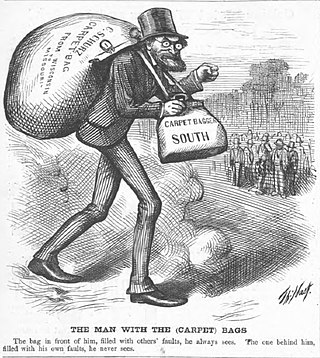
In the history of the United States, carpetbagger is a largely historical term used by Southerners to describe opportunistic Northerners who came to the Southern states after the American Civil War, who were perceived to be exploiting the local populace for their own financial, political, and/or social gain. The term broadly included both individuals who sought to promote Republican politics and individuals who saw business and political opportunities because of the chaotic state of the local economies following the war. In practice, the term carpetbagger was often applied to any Northerners who were present in the South during the Reconstruction Era (1865–1877). The term is closely associated with "scalawag", a similarly pejorative word used to describe native white Southerners who supported the Republican Party-led Reconstruction.

John Gayle was the 7th Governor of Alabama, a United States representative from Alabama, a justice of the Supreme Court of Alabama and a United States district judge of the United States District Court for the Middle District of Alabama, the United States District Court for the Northern District of Alabama and the United States District Court for the Southern District of Alabama.

William Crawford Gorgas KCMG was a United States Army physician and 22nd Surgeon General of the U.S. Army (1914–1918). He is best known for his work in Florida, Havana and at the Panama Canal in abating the transmission of yellow fever and malaria by controlling the mosquitoes that carry these diseases. At the time, his strategy was greeted with considerable skepticism and opposition to such hygiene measures. However, the measures he put into practice as the head of the Panama Canal Zone Sanitation Commission saved thousands of lives and contributed to the success of the Canal's construction.

Josiah Gorgas was one of the few Northern-born Confederate generals and was later president of the University of Alabama.
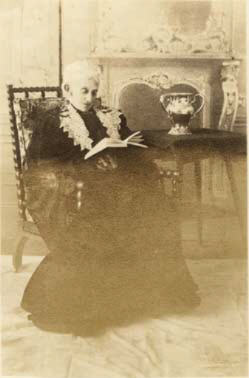
Amelia Gayle Gorgas was librarian and postmaster of the University of Alabama for 25 years until her retirement at the age of eighty in 1907. She expanded the library from 6,000 to 20,000 volumes. The primary library at the university is named after her. A native of Greensboro, Alabama, Amelia was the daughter of Alabama governor John Gayle, the wife of Pennsylvania-born Confederate general Josiah Gorgas and the mother of Surgeon General William C. Gorgas. She was inducted into the Alabama Women's Hall of Fame in 1977.

This is a selected bibliography of the main scholarly books and articles of Reconstruction, the period after the American Civil War, 1863–1877.
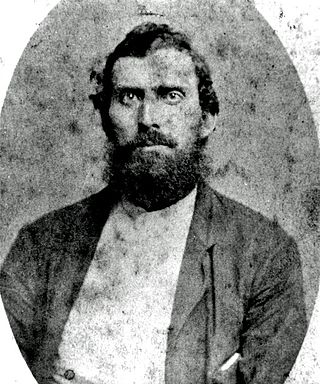
In the United States, Southern Unionists were white Southerners living in the Confederate States of America opposed to secession. Many fought for the Union during the Civil War. These people are also referred to as Southern Loyalists, Union Loyalists, or Lincoln's Loyalists. Pro-Confederates in the South derided them as "Tories". During Reconstruction, these terms were replaced by "scalawag", which covered all Southern whites who supported the Republican Party.

Thornhill is a historic plantation near Forkland, Alabama. The Greek Revival main house was built in 1833 by James Innes Thornton. The house was placed on the National Register of Historic Places on May 10, 1984.

The lily-white movement was an anti-black political movement within the Republican Party in the United States in the late 19th and early 20th centuries. It was a response to the political and socioeconomic gains made by African-Americans following the Civil War and the Thirteenth Amendment to the Constitution, which eliminated slavery and involuntary servitude "except as punishment for a crime".

The Quad is an approximately 22-acre (8.9 ha) quadrangle on the campus of the University of Alabama located in Tuscaloosa, Alabama. Home to most of the university's original buildings, this portion of the campus remains the geographic and historic center of the modern campus. Originally designed by noted English-born architect William Nichols, construction of the university campus began in 1828, following the move of the Alabama state capital from Cahaba to Tuscaloosa in 1826. The overall design for this early version of the campus was patterned after Thomas Jefferson's plan for the University of Virginia, with its Lawn and Rotunda. Following the destruction of the campus during the American Civil War, a new Quad emerged in the late 19th and early 20th centuries. Different in form and function from the original design of the early 19th century, the modern Quad continues to fill its role as the heart of the campus. Although surrounded by academic and administrative buildings, only five structures are built directly on the Quad: the Little Round House, Tuomey Hall, Oliver-Barnard Hall, Amelia Gayle Gorgas Library, and Denny Chimes. The remainder of the space is occupied by a grove of trees on the west side and a great lawn on the east. A feature on the northwestern side, known as The Mound, is the site of the old Franklin Hall. A popular gathering place, the Quad is home to pep rallies, a bonfire during homecoming, and numerous day-to-day student activities.

William Nichols, Sr. was an English-born architect who emigrated to the United States and became most famous for his early Neoclassical-style buildings in the American South. He designed statehouses for North Carolina, Alabama and Mississippi.

The Gorgas–Manly Historic District is a historic district that includes 12 acres (4.9 ha) and eight buildings on the campus of the University of Alabama in Tuscaloosa, Alabama. The buildings represent the university campus as it existed from the establishment of the institution through to the late 19th century. Two buildings included in the district, Gorgas House and the Little Round House, are among only seven structures to have survived the burning of the campus by the Union Army, under the command of Brigadier General John T. Croxton, on April 4, 1865. The other survivors were the President's Mansion and the Old Observatory, plus a few faculty residences.

Julius Adolphus De Lagnel, was a Confederate States Army officer, who was appointed and confirmed as a brigadier general, during the American Civil War, but who declined the appointment. He was second in command to Brigadier General Josiah Gorgas in the Confederate Ordnance Bureau and at times was an inspector of arsenals. Before the war, he served in the United States Army from March 8, 1847, until May 17, 1861. After the war, he was engaged in Pacific steamship service.
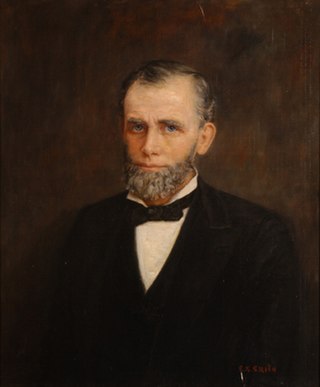
Nathaniel Thomas Lupton was an American chemist and university professor. He served as the President of the University of Alabama from 1871 to 1874. Additionally, he served as State Chemist of Alabama.
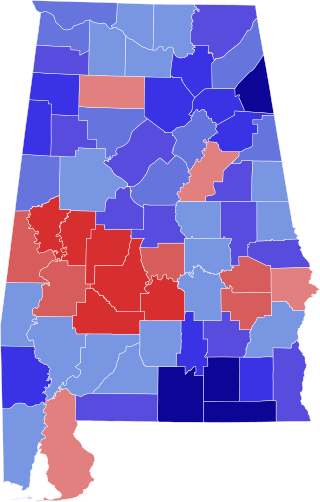
The 1874 Alabama gubernatorial election took place on November 3, 1874, in order to elect the governor of Alabama. Incumbent Republican David P. Lewis unsuccessfully ran for reelection, losing to Democratic former U.S. Representative George S. Houston. This election would end an era of serious competition between the local Democratic and Republican parties, and start a 112-year win streak for Democrats in the gubernatorial level.
Nimrod Snoddy was an A. M. E. preacher who served in the Alabama Legislature during the Reconstruction era. He was elected to the Alabama House of Representatives in 1876 representing Greene County, Alabama. He held substantial property in 1870 and was living in Greene County, Alabama.
Rev. Arad Simon Lakin was an American minister, and university president. He was a Methodist minister from New York state, sent to Alabama in order to reestablish the national Methodist Church in the state, and was labeled a "carpetbagger" by Southerners.
Prince Gardner was a state legislator in Alabama. He served in the Alabama House of Representatives in 1874 until he was unseated.
Sarah Ann Haynsworth Gayle was a 19th-century American diarist, who kept a journal during the period of 1827 to 1835. According to the Encyclopedia of Alabama, "Her journal is unique as the only surviving account of early Alabama life written by a woman." In 2016, she was inducted into the Alabama Women's Hall of Fame.
References
- 1 2 3 Cobb, Mark Hughes. "A historic life". Tuscaloosa News.
- ↑ Noe, Kenneth W. (December 31, 2013). The Yellowhammer War: The Civil War and Reconstruction in Alabama. University of Alabama Press. ISBN 9780817318086 – via Google Books.
- ↑ Wiggins, Sarah Woolfolk (December 31, 1965). "The Role of the Scalawag in Alabama Reconstruction". Louisiana State University – via Google Books.
- ↑ Wiggins, Sarah Woolfolk (July 30, 1977). The Scalawag In Alabama Politics, 1865–1881. University of Alabama Press. ISBN 9780817305574 – via Google Books.
- ↑ Wiggins, Sarah Woolfolk (December 31, 2005). Love and Duty: Amelia and Josiah Gorgas and Their Family. University of Alabama Press. ISBN 9780817314804 – via Google Books.
- ↑ Gayle, Sarah Haynsworth (November 5, 2013). The Journal of Sarah Haynsworth Gayle, 1827–1835: A Substitute for Social Intercourse. University of Alabama Press. ISBN 9780817313333 – via Google Books.